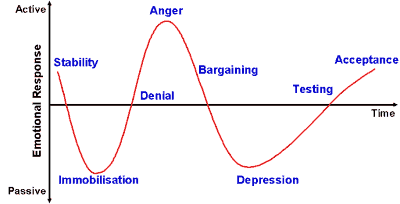 |
| Prescriptive photomontage for Shirley H |
Retelling the story of loss hurts. A normal component of grief recovery, it is often as painful as the loss itself. I remember one widow's words which always stuck with me - perhaps because she was so uninformed of other more art-centered options besides interpersonal psychotherapy, bereavement support groups and anti-depressants. Sixty-six years of age, this woman had begun treatment 20 years after the death of her husband for complicated grief. In
The New York Times article ("
After a Death, the Pain That Doesn't Go Away," Sept. 9, 2009), she tells journalist Fran Schumer about her experience of recounting loss: "That was just brutal and I had to relive it. I nearly dropped out, but I knew this was my last hope of getting any kind of functional life back."
However, times appear to be changing. In Ruth Davis Konigsberg's recent article in
Time Magazine ("Good News About Grief," Jan 24, 2011), there is a new movement underfoot, re-examining Kübler-Ross's "American Way of Grief," namely:
- expressing your grief by telling your story often and in detail
- grieving in stages, from shock to acceptance, in that order
- accepting mandatory "aftercare services" (a.k.a. bereavement counseling)
Kübler-Ross's 7 Stages of Grief
I am a strong believer in resilience, but also in a griever's ability to dream and hope. What if this same patient - in addition to exploring counseling - might also have engaged in creative play, for example, with a prescriptive artist who would have focused her on a new, more hopeful narrative for the future? Who could help her capture the intangible in a metaphorical rather than strictly literal way?
Receiving custom artwork under any circumstance is a special treat. Positive visualizations of the future by a prescriptive photomontage artist, for example, are even more of a treat. Why? Because personal photos previously steeped in sadness are given an entirely positive spin, so that they can tell a story of redemption that stars the griever in an epic role - a role where they are no longer The Griever. By "treat," I am talking about both a process and product that refreshingly doesn't look or feel like therapy because it is art fashioned by an artist and not the patient. Art conceived to make the griever feel more whole and less raw in their grief ... without hurting them further.
Konigsberg sums up the "New Pessimism" towards grief counseling when she concludes with these words:
"It certainly seems time to move beyond our current habit of using untested theories to create unnecessarily lengthy - and agonizing - models for coping with grief that have created more anxiety about the experience instead of alleviating it."
I couldn't agree more. Bring all options to the table. Just don't forget to reach underneath and pull out that drawer of treats.




